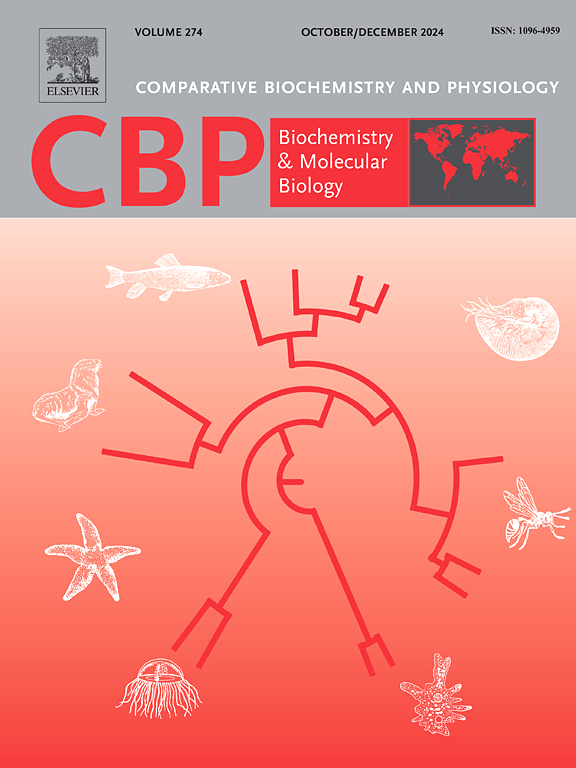Effects of dietary corn silk (Zea mays L.) on growth, immune and antioxidant pathways, histological morphology, gut microbiome, and sensitivity to acute ammonia exposure in the koi carp (Cyprinus carpio var. koi)
IF 1.8
3区 生物学
Q4 BIOCHEMISTRY & MOLECULAR BIOLOGY
Comparative Biochemistry and Physiology B-Biochemistry & Molecular Biology
Pub Date : 2025-07-07
DOI:10.1016/j.cbpb.2025.111127
引用次数: 0
Abstract
Corn silk is a promising aquafeed additive due to its antioxidant, antibacterial, and anti-inflammatory properties. This study evaluated the impact of graded dietary levels of powdered corn silk (PCS) on growth, immunity, antioxidant enzyme activities, histology, gut microbiota composition, gene expression profiles, and sensitivity to acute ammonia exposure in koi carp (Cyprinus carpio var. koi). A total of 300 fish were assigned to five dietary treatments (0, 5, 10, 20, and 30 g/kg PCS) for eight weeks. Fish fed the PCS-30 diet showed significant improvements in growth parameters, including weight gain (WG) and specific growth rate (SGR) (p < 0.05). Antioxidant capacity (2,2′-azino-bis (3-ethylbenzothiazoline-6-sulfonic acid); ABTS) and superoxide dismutase (SOD) activity, increased dose-dependently, while malondialdehyde (MDA) levels remained unchanged (p > 0.05). Expression of the immune and antioxidant genes interleukin 8 (il-8), lysozyme (lyz), catalase (cat), nuclear factor-κB (Nf-κB), and toll-like receptor 4 (tlr4) was significantly upregulated in the PCS-20 and PCS-30 groups (p < 0.05). Histological analysis revealed progressive improvements in anterior intestinal morphology, with the PCS-30 group exhibiting the greatest villus height and width. Gut microbiota analysis showed increased relative abundance of beneficial taxa (Gammaproteobacteria, Lactobacillales, Prevotella), which positively correlated with growth and antioxidant markers, and negatively with MDA levels. Survival under acute ammonia exposure was highest in the PCS-20 and PCS-30 groups. These findings demonstrate the efficacy of PCS, particularly at 30 g/kg, in enhancing growth, immunity, and stress resilience.

饲粮添加玉米丝对锦鲤生长、免疫和抗氧化途径、组织学形态、肠道微生物组以及急性氨暴露敏感性的影响
玉米丝具有抗氧化、抗菌和抗炎的特性,是一种很有前途的水产饲料添加剂。本试验研究了不同饲料水平玉米丝粉(PCS)对锦鲤生长、免疫、抗氧化酶活性、组织学、肠道菌群组成、基因表达谱和急性氨暴露敏感性的影响。将300尾鱼分为5种饲料处理(0、5、10、20和30 g/kg PCS),为期8周。饲喂PCS-30饲料的鱼在增重(WG)和特定生长率(SGR)等生长参数方面均有显著提高(p 0.05)。免疫和抗氧化基因白介素8 (il-8)、溶菌酶(lyz)、过氧化氢酶(cat)、核因子-κB (Nf-κB)和toll样受体4 (tlr4)的表达在PCS-20和PCS-30组中显著上调(p
本文章由计算机程序翻译,如有差异,请以英文原文为准。
求助全文
约1分钟内获得全文
求助全文
来源期刊
CiteScore
4.60
自引率
4.50%
发文量
77
审稿时长
22 days
期刊介绍:
Comparative Biochemistry & Physiology (CBP) publishes papers in comparative, environmental and evolutionary physiology.
Part B: Biochemical and Molecular Biology (CBPB), focuses on biochemical physiology, primarily bioenergetics/energy metabolism, cell biology, cellular stress responses, enzymology, intermediary metabolism, macromolecular structure and function, gene regulation, evolutionary genetics. Most studies focus on biochemical or molecular analyses that have clear ramifications for physiological processes.

 求助内容:
求助内容: 应助结果提醒方式:
应助结果提醒方式:


